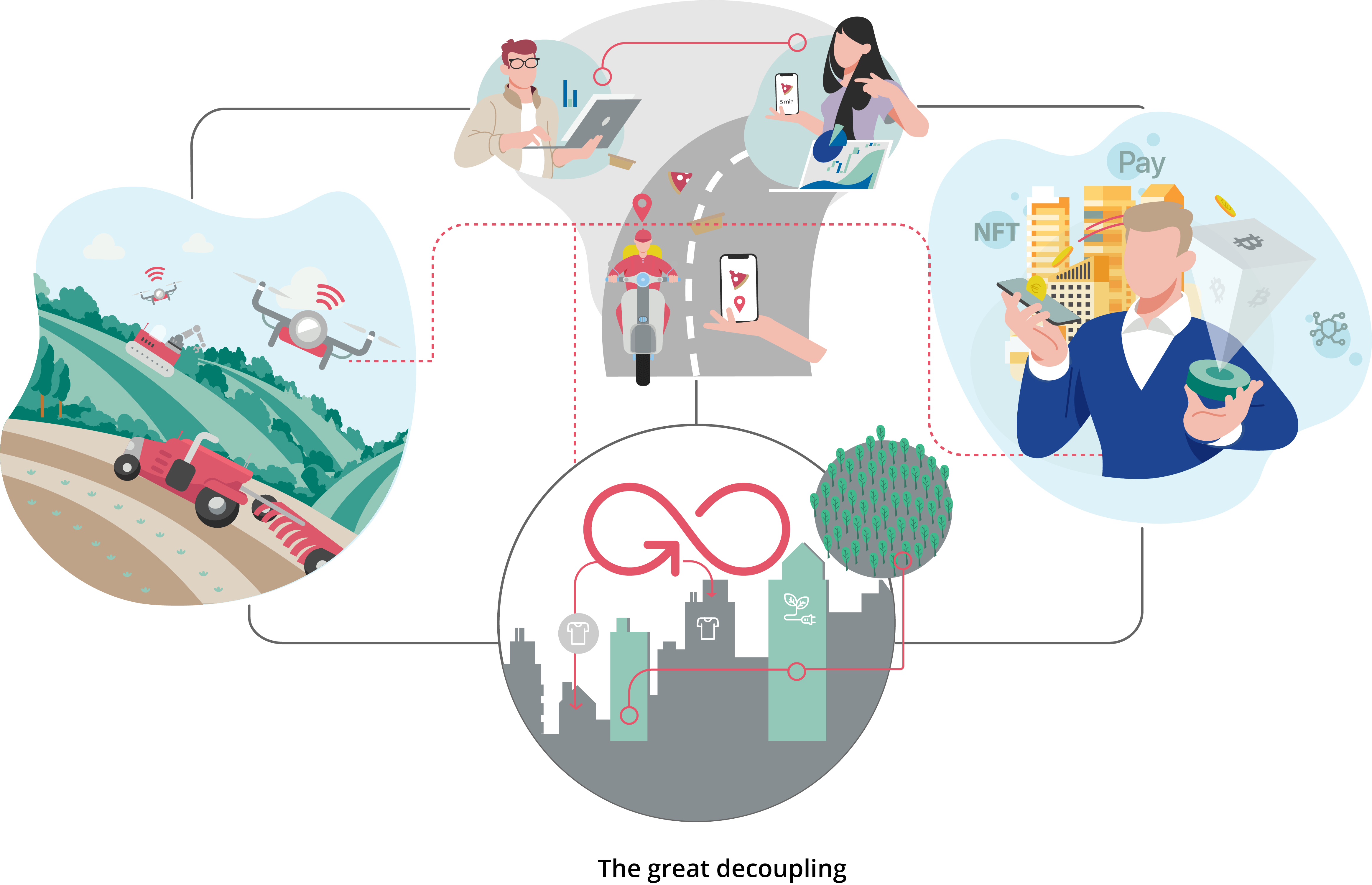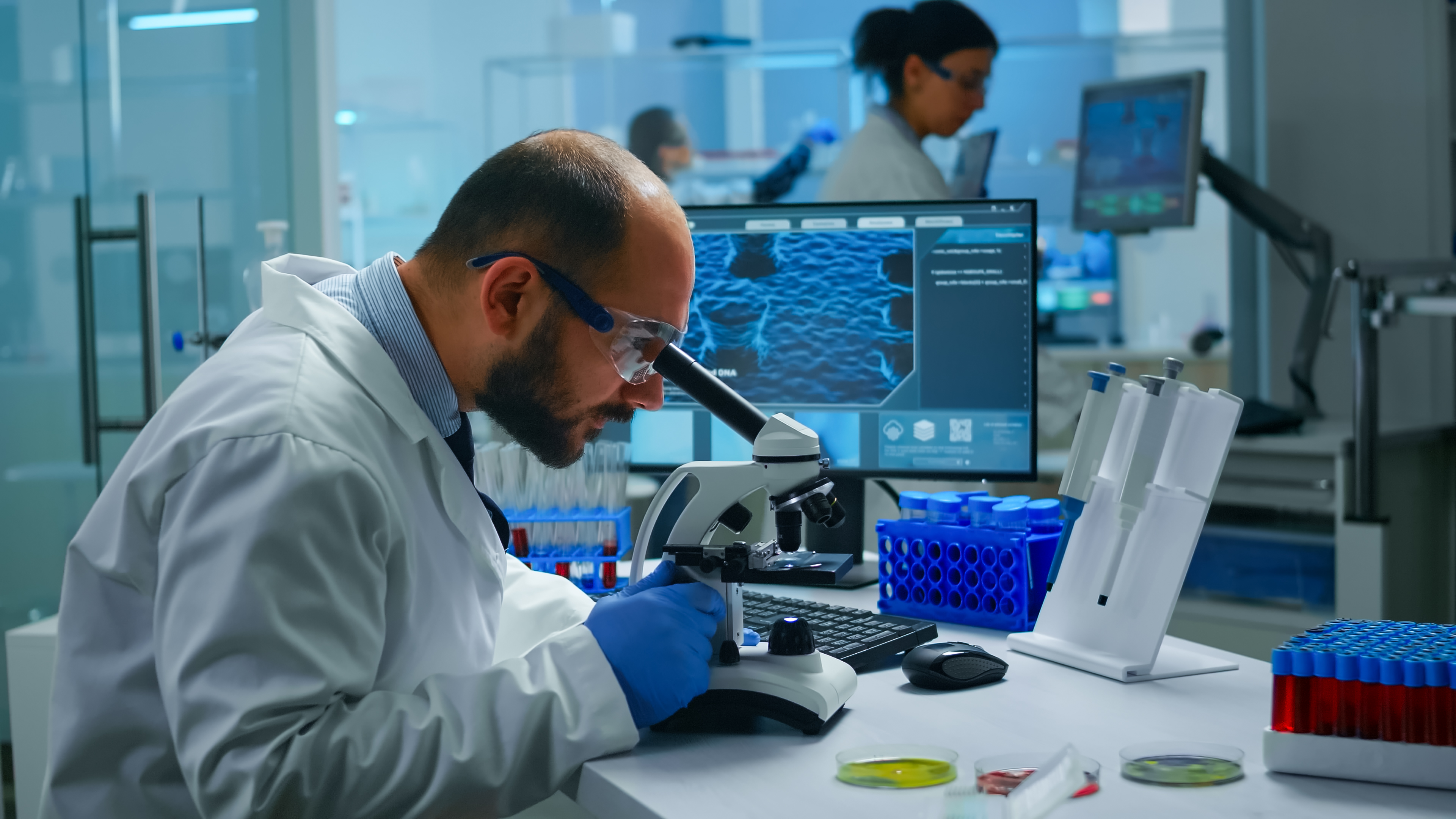Innovation drives green growth
In 2050, Europe’s economy is growing strongly while remaining within environmental boundaries. Technological breakthroughs and related shifts in social practices and norms have enabled an extraordinary decoupling of GDP growth from adverse environmental impacts. Economic growth has generated the resources to invest in rapid innovation, to continue investing in the upgrading of energy, mobility and food systems and the built environment, and to address the impacts of climate change. Green lifestyles have become the norm, with new technologies driving the adoption of new habits and routines. Resource efficiency and circularity are fully integrated into daily life.

It is debatable whether these breakthroughs were mainly driven by intelligently designed innovation policies or the need to cope with acute resource security concerns linked to shrinking resource stocks and severe disruptions in access to fossil fuels from Russia in the 2020s. A dramatically deteriorating global food situation created new opportunities for innovators in the European agri-food sector.
The biotech revolution
The effects of rapid technological and social innovation are particularly evident in the bioeconomy, which is the most dynamic part of the economy. Innovations are blossoming in areas from primary biomass production (e.g. plants, algae, bacteria), through biotechnology (e.g. cell factories, bio-based plastics), to innovative, circular business models and a flourishing, globally competitive health sector. Complex secondary and tertiary production processes enable high levels of circularity of biomaterials, reducing demand for critical resources from outside the EU. Fossil fuel substitution has been largely achieved through increased production of alternative fuels such as algae-based biofuels, ‘green roof tiles’ capable of photosynthesis, developments in the production of ‘green hydrogen’ and the cascading uses of agricultural waste.

© Designed by DCStudio on Freepik
Despite growing climate change impacts, frequent droughts and floods, crop yields are increasing. Large-scale farms use data analytics, improved sensor technology and drones to collect data. Agro-ecosystem design — partly based on genetically modified species — has become a new technoscience. Agricultural automation goes far beyond precision farming. Significant biotechnological advances enable environmental restoration and play a key role in addressing pollution in the countryside, on former brownfield sites and in urban areas.
Vertical farming has become mainstream in European cities. Traffic is based largely on biofuels and hydrogen, with a good share of electromobility in small vehicles. Unexpectedly, health care, an important issue for ageing populations, has not drained public resources, but inspired innovation and stimulated growth. Globally, European firms are among the top companies in fields as different as biomedical nanorobotics, pharmaceuticals, advanced tissue engineering and xenotransplantation, artificial organs and service robotics. European universities and research institutes specialising in biomedical and biotechnical fields attract students and researchers from all continents.
Liberalised markets
However, this success story is not exclusively based on the ‘biotechnology revolution’. Efficient, liberal markets have played a central role in enabling green growth, with government interventions playing an essential role in correcting market failures and driving forward innovation. In the late 2020s and early 2030s, economic development in most European nations suffered from ageing and shrinking populations, with weak growth and high unemployment rates despite (or because of?) ‘baby boomers’ leaving the workforce.
Governments across Europe had to respond. They liberalised labour laws and lowered corporate tax rates, while investing in research, skills, experimentation and learning. Environmental, resource and consumption taxes helped to sustain tax revenues and incentivise green innovation but also had regressive effects. Competition between EU Member States increased in many fields: in fiscal/taxation issues, in approaches to ‘liberalising labour’, in regulation of biotechnology, etc.
In response to divergent economic development and a further spreading of national debt burdens, the eurozone has broken up. In the immediate aftermath of the ‘Euroxit’ (some called it ‘Eurocide’), economic and political disruptions shook the EU. In the end, however, a weaker EU provided a more flexible policy environment, better adapted to national realities — even if it also meant that EU countries were no longer major players in the global arena.
In 2050, cooperation between EU countries is pragmatic. Members States focus on a small number of areas of European competence. National policies are debated and adopted, with a prominent role for civil society organisations as accepted mediators between policymakers and the public, ensuring a functioning exchange between stakeholders.

© Designed by Freepik
Flexibility and mobility
The emphasis is on creativity, flexibility and mobility. Following the liberal ethos, policy aims for equality of opportunity, rather than equality of outcomes. Government policies actively promote the emergence of disruptive innovations and entrepreneurship that can drive transformative change. At the same time, policies also constrain the power of incumbents and limit monopoly power, including the power of the new giant biocompanies (the ‘hulks’, as the media call them). The result is a highly competitive market characterised by diverse platforms. National currencies are increasingly complemented and replaced by digital alternatives operated by multinational companies.
Alongside and in combination with the bioeconomy, robotics, automation and AI are thriving, driving productivity gains and economic growth. This creates an uncertain work environment, especially for low- and medium-skilled workers, but the labour market is adapting. Booming labour platforms create new kinds of ‘crowd working’, with short-term ‘gig’ engagements expanding rapidly at the expense of full- or part-time employment. Leisure and working time merge seamlessly. Job insecurity and inequality are generally accepted because social mobility is high, and growth means that governments have resources to finance generous social protection (e.g. unemployment benefits), retraining for new jobs in different branches of the bioeconomy and fiscal transfers to households or communities in need of support.
In the middle of the century, Europe has become a patchwork of specialised, highly dynamic regions where new, sustainable industries and services flourish, alongside rather depopulated regions that are left to ‘rewild’, used for recreation or employed to generate bioresources.



Document Actions
Share with others